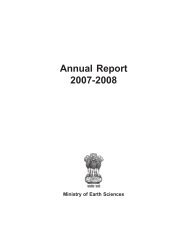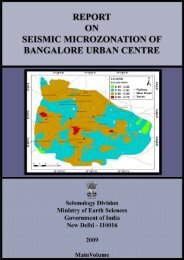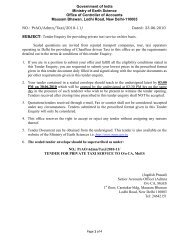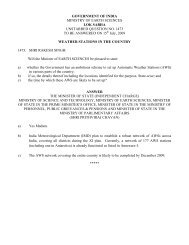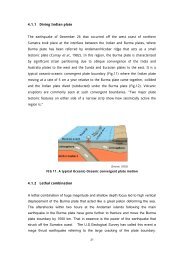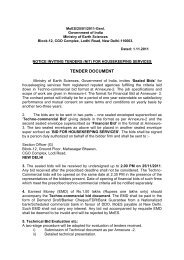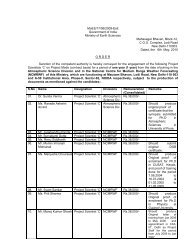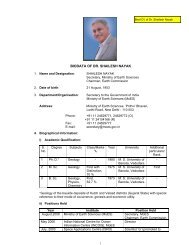Annual Report 2009-2010 - Ministry Of Earth Sciences
Annual Report 2009-2010 - Ministry Of Earth Sciences
Annual Report 2009-2010 - Ministry Of Earth Sciences
You also want an ePaper? Increase the reach of your titles
YUMPU automatically turns print PDFs into web optimized ePapers that Google loves.
year <strong>2009</strong>-<strong>2010</strong> (up to 31.12.<strong>2009</strong>), 49 projects<br />
have been completed and results communicated<br />
to concerned project authorities.<br />
9.3 Drought Monitoring<br />
Droughts are the result of acute water shortage<br />
due to lack of rains over extended periods of<br />
time affecting various human activities and<br />
lead to problems like widespread crop failure,<br />
unreplenished ground water resources, depletion<br />
in lakes/reservoirs, shortage of drinking water and,<br />
reduced fodder availability, etc. <strong>Of</strong>ten a region<br />
adapts itself to a certain level of water shortage<br />
based on the long-term climatic conditions<br />
experienced by it. Any negative departure from<br />
these levels creates conditions of drought,<br />
depending on the intensity and duration of this<br />
deficit. Thus drought conditions differ from<br />
region to region. In India, drought essentially<br />
occurs due to failure of south-west monsoon (June<br />
– September). Areas affected by drought need to<br />
wait till the next monsoon, as more than 73% of<br />
annual rainfall in the country is received during<br />
the SW Monsoon season.<br />
The IMD carries out the function of drought<br />
monitoring and forecasting. Weekly scale<br />
monitoring of the district/sub-divisional/state<br />
level rainfall and temperature scenarios are<br />
analysed using all available observations and<br />
provided to the state governments. Rainfall forecast<br />
assessment at the sub-divisional scale is provided<br />
for the subsequent week on every Friday at the<br />
Crop Weather Watch Group (CWWG) meetings of<br />
the Agricultural <strong>Ministry</strong> at Delhi.<br />
A weekly National Agro-meteorological Advisory<br />
Bulletin (NAAB) is prepared with a comprehensive<br />
analysis of the prevailing temperature and rainfall<br />
scenario and the forecast assessment of the<br />
rainfall for the next week along with specific crop<br />
advisories at the meteorological sub-division scale<br />
for regularly assessing the prevailing scenario/<br />
emerging prospects for the various weather<br />
dependent agricultural operations. NAABs are<br />
widely circulated to various central and state<br />
government agencies for planning various<br />
contingency operations and market interventions<br />
as appropriate.<br />
9.4 Cyclone Forewarning Services<br />
The North Indian Ocean witnessed the formation<br />
of eight cyclonic disturbances during <strong>2009</strong><br />
including one severe cyclonic storm, three<br />
cyclonic storms, one deep depression and three<br />
depressions. Out of these disturbances, five<br />
formed over the Bay of Bengal and three over<br />
the Arabian Sea. Out of four cyclones, the Bay of<br />
Bengal witnessed cyclonic storm, BIJLI during<br />
April, severe cyclonic storm, AILA during May,<br />
cyclonic storm, WARD during December and the<br />
Arabian Sea witnessed the only cyclonic storm,<br />
PHYAN during November <strong>2009</strong>. The tracks of the<br />
cyclonic disturbances during <strong>2009</strong> are shown in<br />
Fig. 9.1. The salient features of these cyclones are<br />
discussed below.<br />
Cyclonic Storm - ‘BIJLI’ (14-17 April <strong>2009</strong>)<br />
The cyclonic storm, ‘BIJLI’ developed from a<br />
persistent convective cloud cluster over the<br />
southeast Bay of Bengal and the adjoining Andaman<br />
Sea from 10 th April and the system concentrated<br />
into a depression on 14 th April afternoon. Moving<br />
in a northwesterly direction, it intensified into a<br />
cyclonic storm “BIJLI” over the west-central Bay<br />
of Bengal on 15 th April. It then re-curved in northeasterly<br />
direction towards Bangladesh coast on<br />
16 th April. However, it gradually weakened prior<br />
to landfall and crossed the Bangladesh coast<br />
close to south of Chittagaon around 2130h IST of<br />
17 th April <strong>2009</strong> as a depression. Climatologically,<br />
cyclogenesis during first fortnight of April is rare.<br />
Only a few number of cyclones have developed<br />
over the Bay of Bengal during 1891-2008 in April.<br />
The tracks of the systems were climatological in<br />
nature as most of the storms developing in the<br />
month of April during 1891-2008 have recurved<br />
towards north-east.<br />
Severe Cyclonic Storm, AILA (23-26 May <strong>2009</strong>):<br />
The severe cyclonic storm, ‘AILA’ developed over<br />
the Bay of Bengal in association with the onset<br />
54 <strong>Ministry</strong> of <strong>Earth</strong> <strong>Sciences</strong> : <strong>Annual</strong> <strong>Report</strong> <strong>2009</strong>-10





